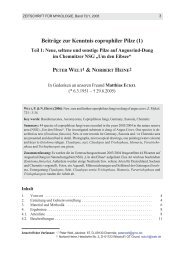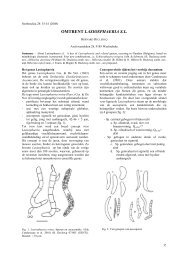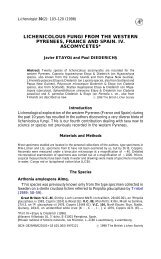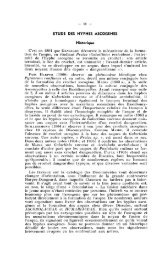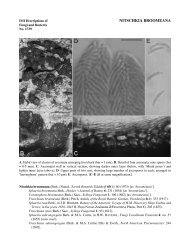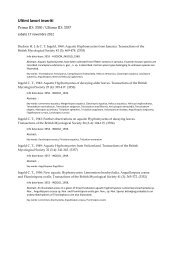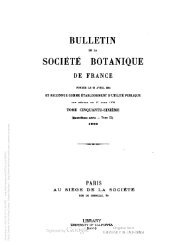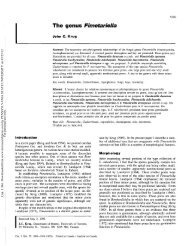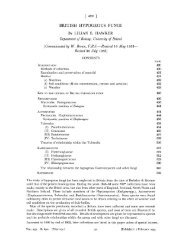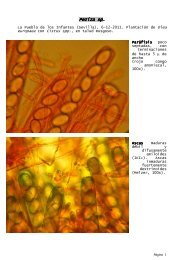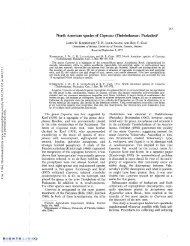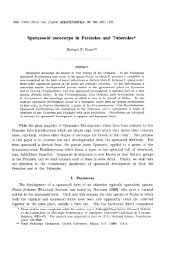Pfister-1973-The-psilopezioid-fungi-IV-Pachyella-0001 - ASCOfrance
Pfister-1973-The-psilopezioid-fungi-IV-Pachyella-0001 - ASCOfrance
Pfister-1973-The-psilopezioid-fungi-IV-Pachyella-0001 - ASCOfrance
You also want an ePaper? Increase the reach of your titles
YUMPU automatically turns print PDFs into web optimized ePapers that Google loves.
39, CUP<br />
: CUP-<br />
i: CUP-<br />
ii: BPI<br />
NY (=<br />
braska :<br />
52279.<br />
5 1564,<br />
, 19472,<br />
37254,<br />
In wet<br />
r. Peck<br />
1-6191,<br />
3-242,<br />
-LP.K.<br />
2676,<br />
W.K.<br />
-2706,<br />
CUP-<br />
d by<br />
CUP-<br />
hyella<br />
ana-<br />
hata,<br />
ished<br />
forth<br />
)f P.<br />
^<br />
J<br />
adnata. Recently I have seen photographs of a<br />
specimen from India which also appears to be<br />
P. clypeata. Seaver (1928) treats this species as<br />
Peziza clypeata.<br />
a (Le Gal) <strong>Pfister</strong>, comb.<br />
nov. Fig. 4a-c<br />
= Galactinia inegalosperma Le Gal, Prodr.<br />
Flore Mycol. Madagascar, 4: 63. 1953. A<br />
name change, non Galactinia macrospora<br />
(Wallr .) Boud.<br />
==. Galactinia pseudosuccosa Le Gal forma<br />
macrospora Le Gal, Rev. Mycol. lO(5-6):<br />
95. 1945.<br />
deziza megulosperma (Le Gal) Eckblad,<br />
Nytt Mag. Bot. 15 : 76. 1968.<br />
Apothecia flat, sessile, becoming somewhat<br />
convoluted and lobed, smooth, blue gray on the<br />
outside, exuding a yellow juice when broken;<br />
hynzenium according to Le Gal "brun roux<br />
brillant" with yellow zones. Ectal excipulum of<br />
globose to elongate cells intermixed with fila-<br />
mentous cells, the globose and elongate cells<br />
reaching a diameter of 32-40 pm, these cells<br />
become smaller toward the outside, and termi-<br />
nate in hyphoid hairs, 5-7 pm in diam, 165-198<br />
pm long, hairs sometimes densely cytoplasmic,<br />
embedded in gel. Medullary excipulum of closely<br />
woven textura intricata, the cells reaching a<br />
diameter of 5-9.6(12.8) pm, occasionally globose<br />
swellings up to 24 pm in diameter present. Sub-<br />
hymenium 50-60 pm thick, composed of globose<br />
and filamentous cells, the walls of which may be<br />
slightly pigmented. Asci J+ (in some cases<br />
slight), long cylindrical, 330-500 X 19-24 /mi.<br />
Ascospores ellipsoid, sometimes almost subfusi-<br />
form (20.5)22.5-28.5 X 10.5-14.5 pm. Para-<br />
physes expanded at the tip to 8-10 pm, filled<br />
apically with dark granules (appearing at times<br />
to be embedded in a gelatinous matrix).<br />
SUBSTRATE AND RANGE: On rotten wood,<br />
among mosses. Madagascar.<br />
NAME: From greek "megus,^ large, and<br />
'sperm," seed or spore, referring to the large<br />
ascospores.<br />
ILLUSTRATIONS: Le Gal, Rev. Mycol. 10. Figs.<br />
1 and 2. 1945. Le Gal, Prodr. Flore Mycol.<br />
Madagascar, 4. Figs. 22-25. 1953.<br />
EXSICCATI : None.<br />
HOLOTYPE: "Ad vetus lignum putridum mus-<br />
cisque coopertum, la fort3 de Fotsialana, Ie 12<br />
novembre 1934." Madagascar.<br />
PFISTER : PSILOPEZIOID FUNGI 2019<br />
SPECIMENS EXAMINED : MADAGASCAR : Sur bois<br />
pourri, for& Fotsialana, 12 novembre 1934, leg.<br />
R. Heim.<br />
NOTES: I find the specimen much as described<br />
by Le Gal (1953b) except for some differences in<br />
measurements. In the only specimen available<br />
to me for study, I found no spores with measure-<br />
ments as large as those listed by Le Gal, though<br />
the spores present appeared to be completely<br />
mature. I did not observe the anastomosis of<br />
paraphyses illustrated and described by Le Gal.<br />
<strong>The</strong> apothecial anatomy agrees perfectly with<br />
that of P. adnata, P. violaceonigra, and P.<br />
clypeata, from which P. megalosperma differs in<br />
its type of spore ornamentation. Eckblad (1968)<br />
included this species in Peziza and stated that the<br />
anatomy "differs slightly from the rest of the<br />
genus [Peziza]."<br />
This species seems rare. It will most likely be<br />
confused with P. violaceonigra, but in that<br />
species the spores are finely marked with small<br />
isolated cyanophilic dots which do not anasto-<br />
mose.<br />
ellapnetisporn <strong>Pfister</strong>, sp. nov. Fig. 5a-d<br />
Apothecium bubalinum, usque ad 2.5 cm<br />
diam, planum. Asci cylindracei, jodo caeru-<br />
lescentes, usque ad 450 pm longi, 19-25 pm diam,<br />
octospori. Ascospori ellipsoidei, biguttulati, 12-<br />
15 X 2 1-25 pm, verrucati, hyalini. Paraphyses<br />
usque ad 8 pm diam, rectae, brunneae.<br />
TYPUS: On wet wood, Gorge of Carp Creek,<br />
Cheboygan Co., Michigan, 27.VI.1969, N. J.<br />
Smith (CUP 52285).<br />
Apothecium flat to concave, attached broadly<br />
but margins free, reaching a diameter of 2.5 cm,<br />
gregarious to scattered, hymenium bay to umber<br />
sometimes with vinaceous tints. Ectal excipulum<br />
textura globulosa to angularis, up to s& cells<br />
thick, merging on the inside almost impercep-<br />
tibly with the medullary excipulum; outer cells<br />
(especially toward the base) 20-40 pm in diam,<br />
terminating in short hyphoid, septate, some-<br />
times appressed hairs up to 5 pm in diam, hairs<br />
longer at point of attachment, sometimes inter-<br />
woven, embedded in gel. Medullary excipulum<br />
textura intricata, gel present, cells short, some-<br />
times constricted at the septa, 5-7 pm in diam.<br />
Asci diffusely J+, contentssometimes becomi<br />
golden in Melzer's reagent, (375-)400-450 X 1<br />
25 jinn. Ascospores ellipsoid, 12-15 X 21-25 pm,<br />
marked with minute cyanophilic warts, one-



